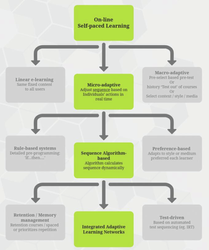Adaptive Learning for Professional Ed
McGraw-Hill (article)
- Meta-cognitive: know thyself → confidence
- Efficiency: deliberate practice
- Engaging: challenged appropriately, per game design
- Retention: long-term knowledge via spaced repetition
Area-9 Learning (infographic)
- Corporate training that
- meets them where they are
- meets the specific needs of their job
- One-size-fits-none, "Biological approach"
- Designing learning programs → creating customized learning paths.
- Retention: Recharges your brain
- Efficiency: Cuts down on learning time by 50%
- Meta-cognitive: Uncovers what you don't know you don't know
- Track Progress: Enables reporting
BitSchool (whitepaper)
CogBooks (whitepaper)
- Categories of self-paced learning platforms
- Linear - fixed linear sequences.
- Negatives: Inefficient; Disengaging
- Macro-adaptive - pre-determined sequence based on either
- Learner's preference
- Negatives: Not supported by research; Extensive authoring effort
- Learner's performance on pretests
- Negatives: "Snapshots" of learner's competency gets outdated; Over-reliance on tests
- Learner's preference
- Micro-adaptive - continuously tailor learning delivery based on the student’s ongoing actions at every step.
- Positives:
- Dynamically adjust based on most recent actions.
- Skip unnecessary activities.
- Automated, personalized support.
- 3 types:
- Preference-based - adapt based on learner's style and behavior
- Negatives: Not supported by research; Extensive authoring effort
- Rule-based - pre-programmed sequence based on user's actions.
- Negatives: Limited extendibility; Extensive authoring effort
- Most applicable to subjects such as basic math and basic science.
- Algorithm-based - data-driven algorithms determine sequence as student progresses.
- Positives:
- Less authoring effort.
- Data-driven: amenable to self-improvement and data analysis.
- 3 types:
- Memory retention - spaced repetition (per pedagogical research)
- Most applicable to memory intensive learning activities such as learning language vocabulary or medical exam study.
- Assessment-driven - optimizes individual assessments and dynamically adjust sequence of assessments.
- Assessments ranked by:
- differentiation (how well they assess what the learner knows)
- difficulty (the relative likelihood that a member of the population will get the assessment correct)
- Frequently uses Item Response Theory.
- Negatives: Heavy focus on testing detracts from learning effectiveness.
- Most applicable to test preparation, exercise drills, and teach-to-test scenarios.
- Assessments ranked by:
- Integrated network - Algorithm determines next best learning item, relying on relationships identified between learning activities.
- Inputs include: learner’s knowledge profile, learner’s behavior, retention, recommendation, and profile data.
- Positives: highly personalized at each step; flexible; scalable for authors; content agnostic; based on recent learning theory.
- Memory retention - spaced repetition (per pedagogical research)
- Positives:
- Preference-based - adapt based on learner's style and behavior
- Positives:
- Linear - fixed linear sequences.
